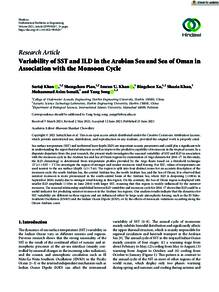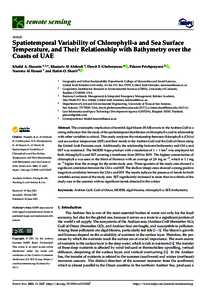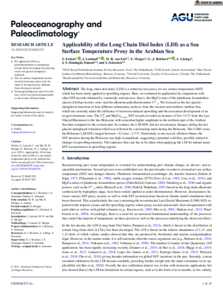Document
Variability of SST and ILD in the Arabian Sea and Sea of Oman in association with the monsoon cycle.
Identifier
DOI: 10.1155/2021/9958257
Source
Mathematical Problems in Engineering. v. 2021, 9958257
Contributors
Piao, Shengchun., Author
Khan, Imran U. , Author
Xu, Bingchen., Author
Khan, Shazia., Author
Ismail, Muhammad Asim., Author
Song, Yang., Author
Country
United Kingdom.
City
London
Publisher
Hindawi Limited.
Gregorian
2021-01-01
Language
English
English abstract
Sea surface temperature (SST) and isothermal layer depth (ILD) are important oceanic parameters and could play a significant role in understanding the upper thermal structure as well as improve the predictive capability of monsoons in the tropical oceans. In a disparate departure from the past research, the present study investigates the seasonal variability of SST and ILD in association with the monsoon cycle in the Arabian Sea and Sea of Oman regions by examination of Argo datasets for 2016-17. In this study, the ILD climatology is determined from temperature profiles provided by the Argo floats based on a threshold technique Tz≥SST-1°C to investigate the region of stronger and weaker monsoon wind forcing. For SST, values of temperature are used nearest to the sea surface (depth z≤5 m). The region is split into four distinct zones for an accurate description of the monsoon cycle: the south Arabian Sea, the central Arabian Sea, the north Arabian Sea, and the Sea of Oman. It is observed that summer monsoon is more pronounced in the south-central basin of the Arabian Sea, where ILD is deepening (>100 m in September 2016) mainly due to stronger wind forcing in this region. On the contrary, the Sea of Oman region is displayed with smaller ILD amplitude (10 m in June 2016) with larger SST, meaning that this region is weakly influenced by the summer monsoon. The seasonal relationship established between ILD variability and monsoon cycle for 2016-17 shows that ILD could be a useful indicator for predicting summer monsoon in the Arabian Sea regions. Our analysis results indicate that the dynamics for SST variability are different in these regions and are influenced either by large-scale atmospheric forcing, such as the El Niño-Southern Oscillation (ENSO) and the Indian Ocean Dipole (IOD), or by the effects of mesoscale variations occurring along the Oman-Arabian coast.
ISSN
1024-123X
Category
Journal articles



